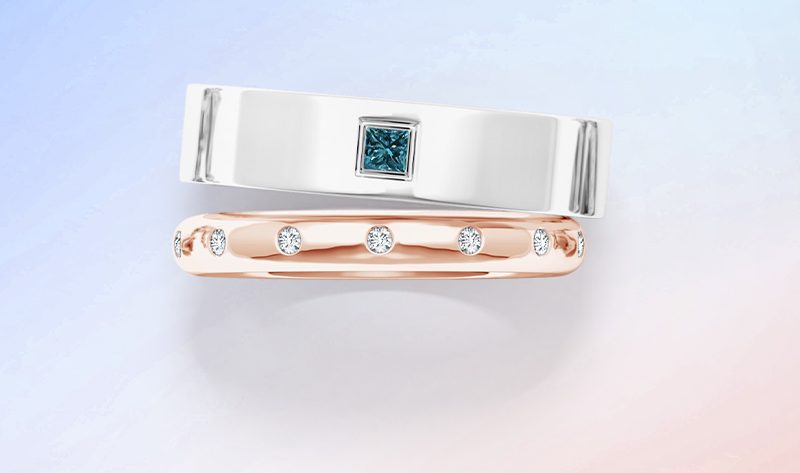For someone who prefers an understated look and practical pieces of jewellery, the flush setting is a fantastic choice. It is one of the most secure stone settings out there and isn’t flashy at all – just the way a minimalist would like it to be.
Go ahead and explore this setting in detail…
What is a flush setting?
The flush setting, also known as “hammered” or “gypsy” setting, sets a gem into a drilled hole in the metal. This means the gemstone sits flush with the surface of the metal and does not protrude. It is visible from the top, while its sides and bottom are embedded in the metal.
To secure the gem in place, the metal is hammered down and there is zero possibility of losing or dislodging the gem over time. As the hammering process is quite intense, the flush setting is not recommended for softer gemstones as they could chip or crack during the process.
Flush setting is often used on dainty, minimalistic jewellery pieces as it downplays the bling on the diamonds and complements the neat and subtle look of the piece. Due to its secure and unobtrusive style, it is also the top choice for men’s wedding bands.
Advantages and disadvantages of the flush setting:
The Advantages:
- Flush setting provides maximum security for the embedded gemstones as there is no risk of them coming loose. Especially for rings and bands, it is a damage-resistant setting as it protects the stones from harsh impacts and daily wear and tear. So, if you have a hands-on job, then a flush-set ring is a great choice for you.
- Flush-set jewellery is completely snag-free as there are no sharp edges or prongs used to secure the gemstones. You can wear flush-set earrings, pendants or rings every day without having to remove them.
- Since there are no nooks or grooves, a flush setting does not allow for dirt to get accumulated. It is hassle-free and extremely simple to clean and maintain.
Flush set jewellery pieces offer a neat, elegant and polished look. So, if flaunting some major bling is not your thing, simply go for flush-set adornments.
The Disadvantages:
- The main disadvantage of the flush setting is that it hinders the visibility of the gemstones. As they are sunk into the metal, the gemstones tend to look smaller than they are with only the top view exposed.
- Flush setting restricts light interaction with the gems, due to its design. This minimizes the brilliance and sparkle of the gemstone.
- The diminished brilliance provided by a flush setting is considered a disadvantage by most people. Therefore, it is not a very common setting and does not help in achieving a striking blingy look.
Flush Setting vs Other Settings
- Flush vs Bezel: Both flush and bezel settings are designed to protect the gemstones with metal surrounding them. But there are some differentiating factors too. In a flush setting, the gem is set into the metal surface and does not protrude. Whereas bezel setting incorporates a strip of metal that wraps around the gem, so it is slightly lifted. Nevertheless, both are practical and snag-free settings.
- Flush vs Channel: Flush and channel settings are similar in a way as the stones are set flush by the metal. But with channel setting, the gems are placed in a continuous row between the metal tracks and in a flush setting, each gem is separately embedded into the metal. Out of the two, the flush setting offers better coverage.
- Flush vs Prong: Though a flush setting is not as versatile as the prong setting, it is one of the choicest ring settings for those who have an active work life. In a prong setting, metal prongs are involved, which tend to wear out over time and snag onto loose threads and hair. Even the gemstone within a prong setting is vulnerable to damage as it tends to protrude on the band. Prong settings are employed for intricate settings or to enhance the brilliance of the main stone. But if you are looking for a simpler and more durable setting, flush or gypsy setting is your type.
In Conclusion
So, do you fancy the high brilliance in a prong-set diamond or the subtle flashes of light on a flush-set diamond? Tell us your thoughts.




























